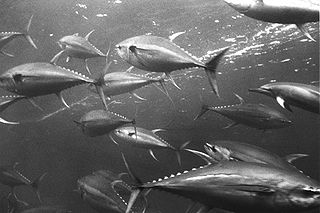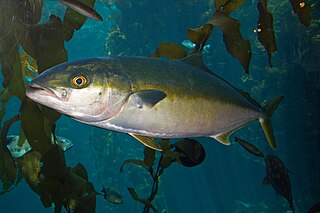
The mackerel, tuna, and bonito family, Scombridae, includes many of the most important and familiar food fishes. The family consists of 51 species in 15 genera and two subfamilies. All species are in the subfamily Scombrinae, except the butterfly kingfish, which is the sole member of subfamily Gasterochismatinae.

Monogeneans, members of the class Monogenea, are a group of ectoparasitic flatworms commonly found on the skin, gills, or fins of fish. They have a direct lifecycle and do not require an intermediate host. Adults are hermaphrodites, meaning they have both male and female reproductive structures.

Bonitos are a tribe of medium-sized, ray-finned predatory fish in the family Scombridae – a family it shares with the mackerel, tuna, and Spanish mackerel tribes, and also the butterfly kingfish. Also called the tribe Sardini, it consists of eight species across four genera; three of those four genera are monotypic, having a single species each. Bonitos closely resemble the skipjack tuna, which is often called a bonito, especially in Japanese contexts.

Menticirrhus is a genus of marine ray-finned fish belonging to the family Sciaenidae, the drums or croakers. They are commonly known as kingcroakers or kingfish. These fish are found in the Western Atlantic and Eastern Pacific Oceans.

The yellowtail amberjack, yellowtail kingfish, hiramasa or great amberjack is a large fish found in the Southern Ocean. Although previously thought to be found in all oceans and seas, recent genetic analysis restricts S. lalandi proper to the Southern Hemisphere waters. However, they are found in Northern Hemisphere waters during certain times of the year. The fish was given its name by Monsieur de Lalande, a naturalist who first informed zoologist Achille Valenciennes of the existence of this species. His reason for the use of the word Seriola to name the fish is uncertain, but the second word lalandi was derived from his surname.

The butterfly kingfish is an ocean-dwelling ray-finned bony fish in the mackerel family, Scombridae – a family which it shares with the tunas, mackerels, Spanish mackerels, and bonitos. It, however, represents a lineage distinct from all other scombrids and has therefore been placed in its own genus Gasterochisma and subfamily Gasterochismatinae.

Scomberomorini is a tribe of ray-finned saltwater bony fishes that is commonly known as the Spanish mackerels, seerfishes or seer fish. This tribe is a subset of the mackerel family (Scombridae) – a family that it shares with three sister tribes, the tunas, mackerels, and bonitos, and the butterfly kingfish. Scomberomorini comprises 21 species across three genera. They are pelagic fish, fast swimmers and predatory in nature, that fight vigorously when caught. They are mainly caught using hooks and lines.

The cero, also known as the pintado, kingfish, cero mackerel, cerite or painted mackerel, is a ray-finned bony fish in the family Scombridae, better known as the mackerel family. More specifically, this fish is a member of the tribe Scomberomorini, the Spanish mackerels, and is the type species of the genus Scomberomorus. It is similar in appearance and coloration to the Atlantic Spanish mackerel, Scomberomorus maculatus, except the cero has a longitudinal stripe in addition to the spots of the Atlantic Spanish mackerel.
A number of Actinopterygiian fish have been given the common name whiting.

The cleftbelly trevally, also known as the cleftbelly kingfish, Kuweh trevally or thin crevalle, is a species of tropical marine fish of the jack family, Carangidae. The species inhabits coastal waters throughout the Indo-West Pacific region from South Africa in the west to Japan in the east, often found near the water's surface. The cleftbelly trevally is the only member of the genus Atropus and is distinguished by a number of anatomical characteristics, with a deep median groove in the belly giving the species its common name. It is not a large fish, growing to a maximum recorded length of 26.5 cm. Cleftbelly trevally are predatory fish, taking a variety of small crustaceans and fish. The species is of minor importance to fisheries throughout its range.

The coastal trevally, also known as the onion trevally, Japanese trevally or bluefin kingfish, is a species of inshore marine fish in the jack family Carangidae. The species is distributed throughout the tropical and subtropical waters of the Indian and west Pacific Oceans, from South Africa in the west to Japan and New Caledonia in the east, reaching as far south as Australia. The species is found on deep coastal reefs, both in schools and as solitary individuals, where they prey on small midwater organisms including crustaceans, small fish and cephalopods. The species is taken as bycatch in a number of fisheries throughout its range by a number of fishing methods and is of little commercial value, but is considered to be a good table fish. A mistype in the original volume in which Eduard Rüppell named the species led to the combination Carangoides caeruleopinnatus, which has incorrectly spread through the literature.

Barbinae are a subfamily of fish included in the family Cyprinidae. The taxonomy for this group has not been entirely worked out as some genera historically considered within it are still considered incertae sedis with respect to being a member of the family, and may be included here, while others may be moved to other subfamilies.

Cyprinion is a genus of ray-finned fish in the family Cyprinidae.

The Assamese kingfish is a species of cyprinid fish native to southern Asia where it occurs in fresh waters of India, Nepal, Bhutan and Myanmar. This species can reach a length of 60 centimetres (24 in) TL. It is of minor importance to local commercial fisheries.

Menticirrhus saxatilis, the northern kingfish or northern kingcroaker, is a species of marine fish in the family Sciaenidae. It lives in the shallow coastal waters of the western Atlantic Ocean and Gulf of Mexico.

The Scombrinae are a subfamily of ray-finned bony fishes in the family Scombridae. Of the 51 species in the Scombridae, 50 are in Scombrinae – with the sole exception being the butterfly kingfish, which is placed in the monospecific subfamily Gasterochismatinae.
Semiplotus cirrhosus is a species of cyprinid in the genus Semiplotus. It inhabits Myanmar and has a maximum length of 4.1 centimetres (1.6 in) among males. It is considered harmless to humans and is classified as "data deficient" on the IUCN Red List.
Semiplotus manipurensis is a species of cyprinid in the genus Semiplotus, that inhabits Manipur, India. Unsexed males have a maximum length of 18.5 centimetres (7.3 in). It is classified as "data deficient" on the IUCN Red List and is considered harmless to humans.

Semiplotus modestus is a species of cyprinid in the genus Semiplotus that inhabits India and upper Myanmar. Unsexed males have a maximum length of 20 centimetres (8 in) and it is considered harmless to humans. It is classified as "data deficient" on the IUCN Red List.














